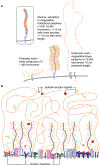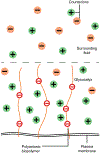Physical biology of the cancer cell glycocalyx
- PMID: 33859716
- PMCID: PMC8046174
- DOI: 10.1038/s41567-018-0186-9
Physical biology of the cancer cell glycocalyx
Abstract
The glycocalyx coating the outside of most cells is a polymer meshwork comprising proteins and complex sugar chains called glycans. From a physical perspective, the glycocalyx has long been considered a simple 'slime' that protects cells from mechanical disruption or against pathogen interactions, but the great complexity of the structure argues for the evolution of more advanced functionality: the glycocalyx serves as the complex physical environment within which cell-surface receptors reside and operate. Recent studies have demonstrated that the glycocalyx can exert thermodynamic and kinetic control over cell signalling by serving as the local medium within which receptors diffuse, assemble and function. The composition and structure of the glycocalyx change markedly with changes in cell state, including transformation. Notably, cancer-specific changes fuel the synthesis of monomeric building blocks and machinery for production of long-chain polymers that alter the physical and chemical structure of the glycocalyx. In this Review, we discuss these changes and their physical consequences on receptor function and emergent cell behaviours.
Conflict of interest statement
Competing interests The authors declare no competing interests
Figures







References
Grants and funding
LinkOut - more resources
Full Text Sources
